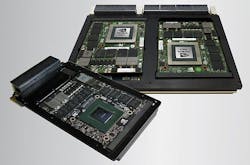Open-architecture GPGPU processor boards for radar and sensor fusion introduced by Curtiss-Wright
ASHBURN, Va. – The Curtiss-Wright Corp. Defense Solutions division in Ashburn, Va., is introducing the rugged VPX3-4924 and VPX6-4944 open-architecture high performance embedded computing (HPEC) processors for use in compute intensive intelligence, surveillance, and reconnaissance (ISR) and electronic warfare (EW) systems.
The NVIDIA Tesla Pascal. (P6) 16-nanometer general-purpose graphics processing unit (GPGPU)-based OpenVPX modules are for sensor fusion or large swath video mapping, that require teraFLOPs of accelerated processing.
With their on-device support for NVIDIA high-performance compute (HPC) mode, these high-performance embedded computing (HPEC) engines can ingest data generated by modern radar, SIGINT, and EO/IR sensors.
The VPX3-4924 module, a 3U OpenVPX GPGPU processor, features one Tesla P6 GPU and delivers 6.2 teraFLOPs performance. For more demanding signal processing applications, the 6U form factor VPX6-4944 deploys dual Tesla P6s, doubling available compute power to 12.4 teraFLOPs.
Related: Curtiss-Wright Controls introduces first Nvidia GPGPU OpenVPX engine
These GPGPU modules enable system designers to capitalize on virtualization via NVIDIA's Virtual GPU (vGPU) graphics virtualization platform, and provide virtual machines (VM) access to NVIDIA GPU technology.
Curtiss-Wright HPEC modules and systems are supported by the OpenHPEC accelerator suite of software development tools, which include the Bright Cluster Manager from Bright Computing, an NVIDIA partner.
For more information contact Curtiss-Wright Defense Solutions online at www.curtisswrightds.com.
Ready to make a purchase? Search the Intelligent Aerospace Buyer's Guide for companies, new products, press releases, and videos

